How do AI detectors work?
Ever wondered how you can tell if something you read online was written by a person or generated by a machine? That’s where AI detectors come in.
AI detectors are tools designed to identify content generated by AI algorithms. With the increasing use of AI in generating text, images, and videos, there is a growing need for mechanisms to help us navigate the fine line between human and AI-created content.
But how exactly do they work? Let’s talk about that.
How Do AI Content Detectors Work?
One common question that gets thrown around a lot when it comes to AI detection is: How do AI detectors work?
AI content detectors use various techniques and technologies to analyze and classify content. Let’s break the process down into simpler terms:
Natural Language Processing (NLP)
Natural Language Processing (NLP) is a crucial component of AI content detectors. NLP involves the use of algorithms to process and understand human language. By leveraging NLP, AI detectors can:
- Analyze Syntax and Grammar: AI detectors examine the structure of sentences, checking for grammatical correctness and natural language flow. Human writing tends to have certain nuances and variations that AI-generated text just doesn’t have.
- Identify Patterns: NLP algorithms can identify patterns typical of AI-generated text like repetitive structures or unnatural phrasing.
Machine Learning Models
Machine learning models are trained on large datasets consisting of both human-written and AI-generated content. These models learn to differentiate between the two by recognizing subtle differences. Key steps include:
- Training Phase: During this phase, the model is exposed to thousands of examples of human and AI-written text. It learns to identify features that distinguish the two types of content.
- Testing Phase: The model is then tested on new, unseen data to evaluate its accuracy. This helps in fine-tuning the model for better performance.
Feature Extraction
AI detectors extract various features from the text to make accurate classifications. Some of these features include:
- Lexical Features: These include word frequency, choice of vocabulary, and stylistic elements that may differ between human and AI writing.
- Syntactic Features: This involves analyzing the arrangement of words and phrases to create well-formed sentences.
- Semantic Features: Understanding the meaning and context of the text helps in identifying the intended message and whether it aligns with typical human communication patterns.
Deep Learning Techniques
Advanced AI detectors use deep learning techniques, such as neural networks, to improve accuracy. These techniques involve:
- Neural Networks: These are computational models inspired by the human brain, capable of recognizing complex patterns in data.
- Transformer Models: Models like GPT-3 (Generative Pre-trained Transformer 3) are used not only to generate content but also to detect AI-generated text by comparing it against known human writing.
Cross-Referencing and Context Analysis
To enhance reliability, AI detectors often cross-reference content with existing databases and analyze the context in which it appears.
- Plagiarism Detection: By comparing the text with a vast database of existing content, AI detectors can identify if parts of the content are copied or heavily influenced by other sources.
- Contextual Relevance: Analyzing the context helps determine if the content fits naturally within its intended use, be it an academic paper, a news article, or a casual blog post.
Do AI Detectors Actually Work?
The effectiveness of AI detectors has been a topic of significant debate, given the rapid advancements in AI text generation technologies.
Understanding whether AI detectors truly work involves evaluating their accuracy, limitations, and the context in which they are applied.
Accuracy of AI Detectors
The accuracy of AI detectors can vary based on several factors, including the sophistication of the detector, the quality of training data, and the type of content being analyzed. Here are some key points:
- High Accuracy in Controlled Settings: In controlled environments where the training data is well-curated and comprehensive, AI detectors can achieve high accuracy rates. For example, some detectors claim accuracy rates above 90% in distinguishing AI-generated text from human-written text.
- Challenges with Ambiguous Content: The accuracy tends to decrease with more ambiguous or creatively written content. AI-generated text that closely mimics human writing can sometimes evade detection.
Limitations of AI Detectors
Despite their capabilities, AI detectors have certain limitations that can affect their performance:
- False Positives and Negatives: AI detectors can produce false positives (flagging human-written text as AI-generated) and false negatives (failing to detect AI-generated text). This is particularly challenging when the text is sophisticated or when AI models are used to paraphrase human-written content.
- Dependence on Training Data: The effectiveness of AI detectors heavily relies on the quality and diversity of their training data. If the training data is biased or incomplete, the detector’s performance can be compromised.
- Evolving AI Models: As AI text generation models become more advanced, they can produce content that is increasingly difficult to distinguish from human writing. This constant evolution requires detectors to adapt rapidly to new techniques and patterns.
10 Best AI Detectors Available Online
Undetectable.ai

Undetectable.ai is considered the best overall AI detector and humanizer. It uses advanced machine learning algorithms to analyze text and detect AI-generated content. The tool is highly accurate and can even humanize AI-generated text to make it indistinguishable from human-written content.
Features:
- Guaranteed Refund: Undetectable AI offers a complete money-back guarantee.
- More than 95% of AI Detectors Passed: The tool consistently beats AI detectors with a success rate of more than 95%.
- Content of High Quality and Credibility: It generates error-free language and creates content that is incredibly readable and professional.
- Typing and Paraphrasing Assistant: A revolutionary technology that combines a typer and a paraphraser to produce writing with the accuracy of a normal human.
Pros:
- Can turn reported AI material into human-like writing
- Improves content quality
- Saves time and money
- Boosts reliability
Cons:
- May raise ethical questions about content authenticity and originality
- May violate specific sites’ terms of service
- May not handle complex or specialized topics
Pricing:
- $5.00 per month (long-term commitment)
- $14.99 per month (monthly plan)
GLTR (Giant Language Model Test Room)
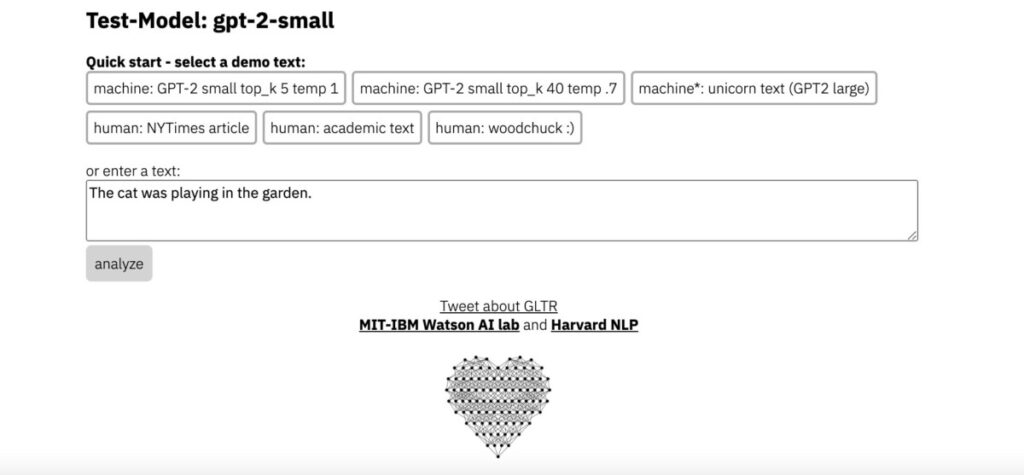
GLTR, developed by researchers from MIT-IBM Watson AI Lab and Harvard NLP, provides a visual representation of the likelihood that a piece of text was generated by an AI. It’s a valuable educational tool for understanding AI text generation.
Features:
- Visual Analysis: Visual representation of word prediction probabilities.
- Open-Source: Available for public use and contribution.
- Educational Tool: Useful for understanding AI text generation.
- Detailed Insights: Offers in-depth analysis of text structure.
Pros:
- Educational and insightful
- Open-source
- Visual and detailed analysis
Cons:
- Requires some technical knowledge to interpret results
Pricing:
- Free and open-source.
Originality AI
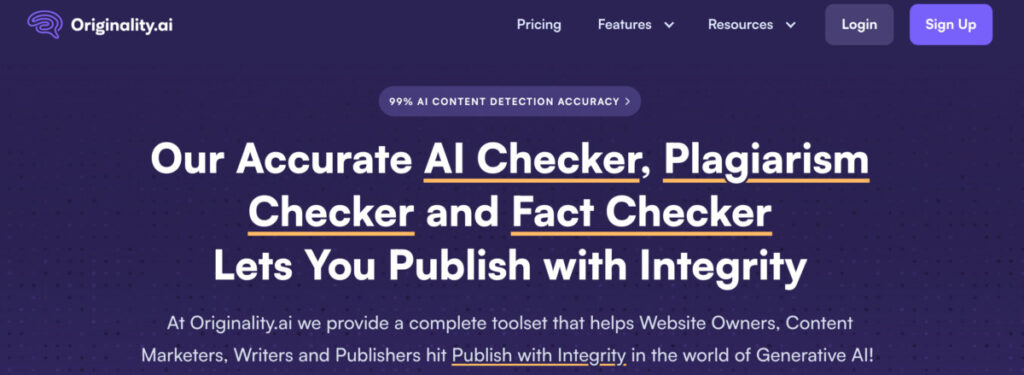
Originality AI is a comprehensive AI checker that can identify AI-generated content with high accuracy. It uses a combination of machine learning algorithms and natural language processing techniques to analyze text and detect potential AI-generated parts.
The tool is highly effective in detecting AI-generated content and is often used by educational institutions and content creators.
Features:
- Detailed Analysis: Comprehensive reports on content originality.
- High Accuracy: Accurate detection of AI-generated text.
- Batch Analysis: Capable of analyzing large volumes of text at once.
- Easy Integration: Simple to integrate into existing workflows.
Pros:
- High accuracy
- Batch analysis capability
- Easy integration
Cons:
- Pay-per-credit pricing can add up for frequent users
Pricing:
- $0.01 per credit, with each credit checking 100 words.
Turnitin
Turnitin is a well-established name in the academic world, known for its powerful plagiarism detection capabilities. With the rise of AI-generated content, Turnitin has expanded its features to include AI writing detection, ensuring academic integrity remains uncompromised.
Features:
- Extensive Database: Access to a vast repository of academic papers and internet content.
- Advanced Algorithms: Sophisticated algorithms for AI text detection.
- User-Friendly Interface: Easy to use with detailed reports.
- Integration: Seamless integration with learning management systems.
Pros:
- Reliable and well-established tool
- Comprehensive plagiarism and AI detection
- Excellent integration capabilities
Cons:
- Custom pricing may be expensive for small institutions
- Primarily designed for academic use
Pricing:
- Custom pricing based on institution size and usage.
Copyleaks

Copyleaks, a well-known plagiarism detection tool, has enhanced its platform to detect AI-generated text as well.
It uses advanced machine learning algorithms to detect AI-generated content and ensure the originality of student work. The tool is highly accurate and can detect AI-generated content with high precision.
Features:
- Extensive Database: Access to a large database for cross-referencing content.
- AI Detection: Advanced algorithms to detect AI-generated content.
- Multi-Language Support: Supports multiple languages.
- Integration: Seamless integration with various platforms.
Pros:
- Wide range of supported languages
- Detailed and accurate detection
- Good integration capabilities
Cons:
- Pricing may be high for individual users
Pricing:
- Pricing starts at $10.99/month for individuals. Custom pricing is available for enterprises.
ZeroGPT
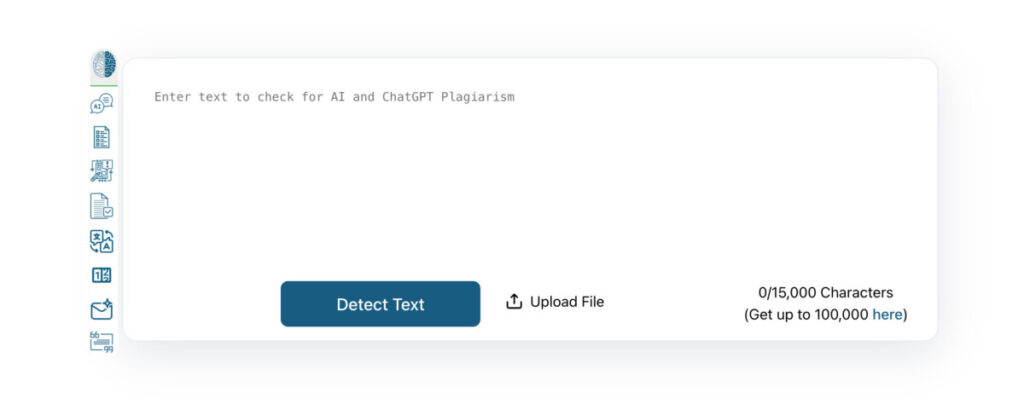
ZeroGPT is a specialized AI checker that uses machine learning algorithms to detect AI-generated content and provide a human content score. The tool is highly effective in detecting AI-generated content and is often used by freelancers to ensure the originality of their work.
Features:
- Specific Algorithms: Tailored to detect content generated by GPT models.
- High Accuracy: Reliable detection of AI-generated text.
- Free to Use: Easily accessible online tool.
- User-Friendly Interface: Simple and straightforward usage.
Pros:
- Tailored for GPT models
- Free to use
- High accuracy
Cons:
- Limited to GPT model detection
- Basic features compared to paid tools
Pricing:
- Free to use.
Sapling
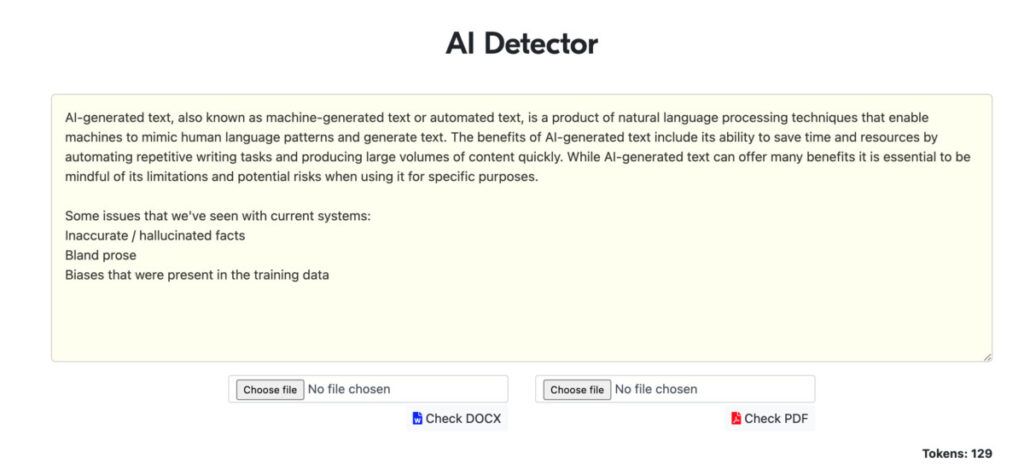
Sapling is an AI detector designed for agencies. The tool is highly effective in detecting AI-generated content and is often used by agencies to maintain the integrity of their content. You can use it to check documents or pdfs.
Features:
- Real-Time Detection: Detects AI-generated content while writing.
- Platform Integration: Works with popular writing and editing platforms.
- Content Suggestions: Offers suggestions to improve content authenticity.
- User-Friendly Interface: Simple and intuitive design.
Pros:
- Real-time detection
- Easy integration with writing platforms
- Content improvement suggestions
Cons:
- Limited to supported platforms
- Higher cost for advanced features
Pricing:
- Free tier available; paid plans start at $25/month.
Crossplag
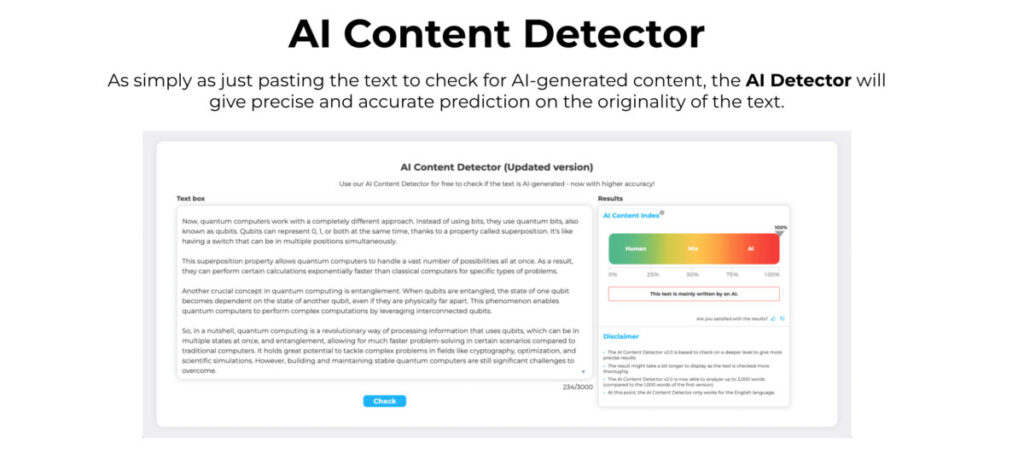
Crossplag offers a powerful AI content detection tool for academic and professional use, supporting various document formats. The tool is highly effective in detecting AI-generated content and is often used by content creators to maintain the integrity of their work
Features:
- Multi-Format Support: Can handle various document formats.
- Detailed Reports: Provides in-depth similarity and originality reports.
- LMS Integration: Compatible with learning management systems.
- User-Friendly Dashboard: Easy to use with comprehensive analytics.
Pros:
- Supports multiple document formats
- Detailed reporting
- Good integration with LMS
Cons:
- Pricing may be high for individual users
Pricing:
- Pricing starts at $10/month for individual users. Custom pricing is available for institutions.
Content at Scale AI Detector
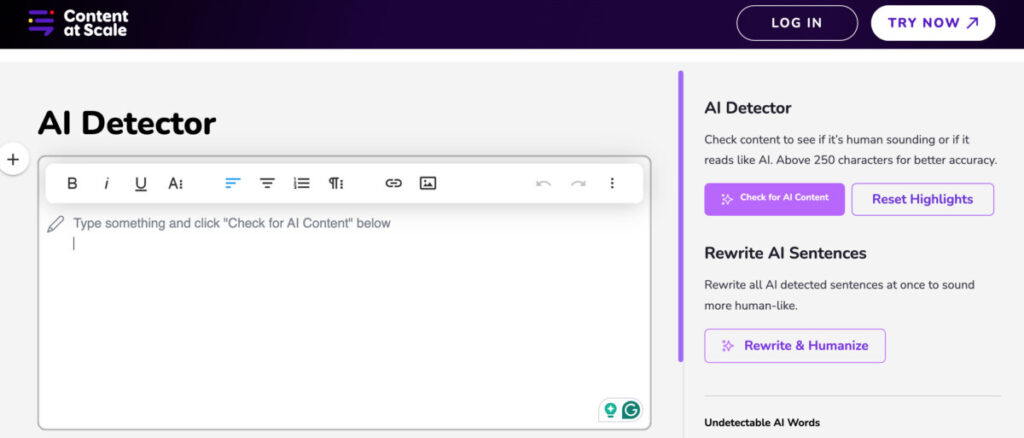
Content at Scale offers a robust AI detection tool designed for content creators and SEO professionals. It helps ensure that content remains original and free from AI-generated text, enhancing its credibility and search engine performance.
Features:
- Comprehensive Analysis: Detailed analysis of text content to ensure originality.
- SEO Integration: Tools to optimize content for search engines.
- Detailed Reports: Highlights AI-generated sections within the content.
- User-Friendly Interface: Easy to navigate with clear results.
Pros:
- SEO integration
- Detailed content analysis
- User-friendly
Cons:
- Custom pricing may be a barrier for small users
Pricing:
- Custom pricing based on user needs.
Winston AI
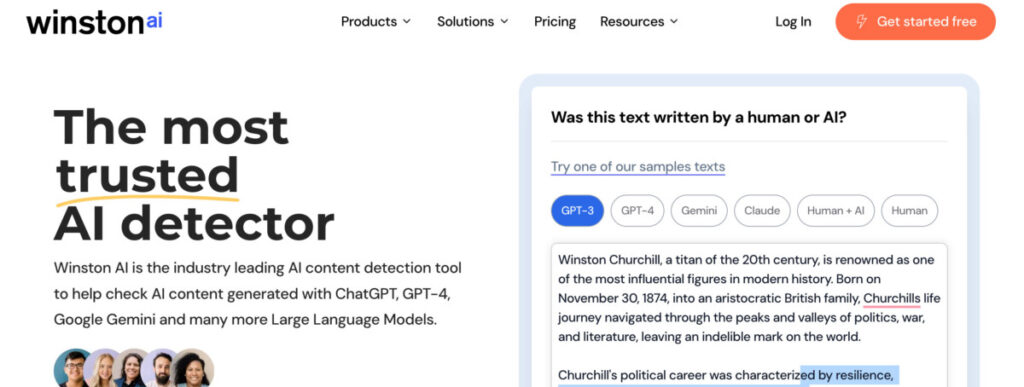
Winston AI offers advanced AI detection capabilities with a focus on high accuracy and user-friendliness. It’s ideal for content creators, educators, and businesses looking to ensure content authenticity.
Features:
- High Accuracy: Uses sophisticated algorithms to detect AI-generated text.
- User-Friendly Interface: Easy to use with clear and detailed reports.
- Real-Time Detection: Provides real-time feedback while writing.
- Integration: Seamlessly integrates with various writing and editing platforms.
Pros:
- High accuracy and reliability
- User-friendly interface
- Real-time detection and feedback
Cons:
- Pricing may be high for small users
- Limited free tier features
Pricing:
- Free tier available; paid plans start at $12/month
The Bottom Line
So, how do AI detectors work? Guess you now have your answer!
In a world where AI-generated content is littered everywhere, AI detectors/checkers are essential tools for ensuring content authenticity.
The future of AI detectors is looking exciting! As AI technology keeps advancing, these detectors will get even better and more accurate. They’ll likely become a natural part of our digital tools, making it easy to catch and fix AI-generated text in real-time.
FAQs
1. How do AI detectors detect AI?
AI detectors analyze text patterns and structures, comparing them to known AI-generated content to identify similarities.
AI detectors have become essential for identifying machine-generated text, but their accuracy remains a topic of debate. For a reliable AI detection tool, check out EduWriter’s AI Content Detector, which helps ensure content authenticity.
2. How to trick AI content detectors?
Tricking AI content detectors is unethical and involves altering text to avoid detection, such as changing sentence structures or word choices.
3. Which is the most accurate AI detector?
Undetectable.ai is considered one of the most accurate AI detectors available.
4. What AI detector do teachers use?
Teachers commonly use tools like Turnitin and GPTZero to detect AI-generated content in student work.
5. How do AI writing detectors work?
AI writing detectors use machine learning algorithms to analyze text patterns, syntax, and semantics to identify AI-generated content.
6. Are AI detectors 100% accurate?
No, AI detectors are not 100% accurate. They can sometimes misclassify human-written content as AI-generated and vice versa.
7. Why do AI detectors say my writing is AI?
AI detectors may flag human writing as AI-generated if it closely matches patterns and structures commonly found in AI-generated content.

